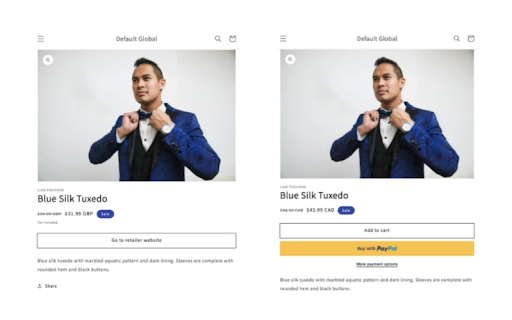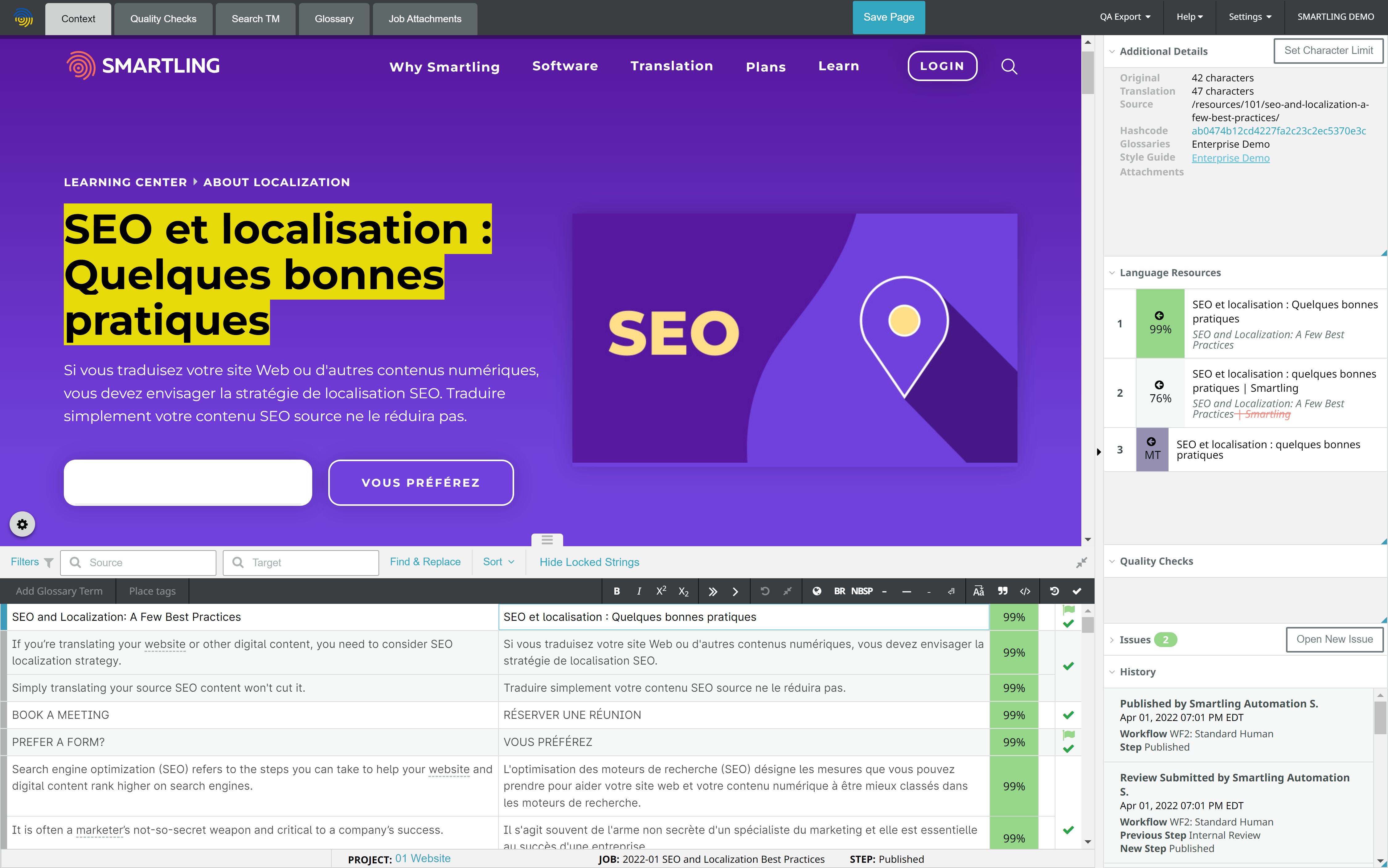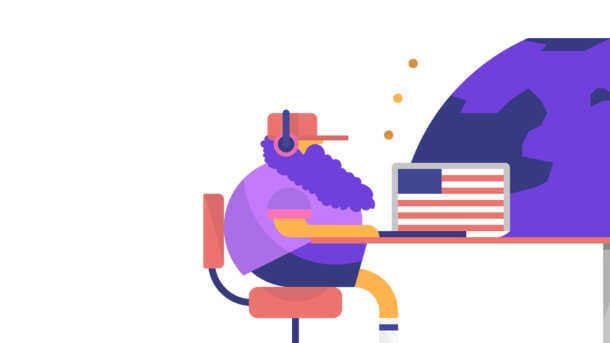U.S. consumers spent $870.78 billion online in 2021, up 14.2% year over year. It’s the highest annual U.S. ecommerce growth over the last two decades. In today’s ecommerce world, your customers expect to be able to buy from you online. In a very real sense, your website is your storefront. But is it an effective one?
As you expand your business into global markets, you need to ensure your website is accessible to those customers too. Research shows that 40% of people won’t buy from websites in other languages. And that 76% of people prefer to buy products with info in their native language. Content translation should be a priority if your goal is to attract customers from foreign markets.
However, building an effective website also requires comprehensive localization. Let’s talk about what that entails.
What is website localization?
Website localization involves adapting your website's user experience (UX) for different regions, languages, and cultures. That includes all of the following elements:
- Language and regionalism: Translate website copy, user interface elements, and other content, including images and videos into the target language.
- Cultural nuances: Account for different cultural sensitivities, local customs and holidays, and differences in standards for dates, times, and measurements.
- Payment systems: Display the correct currency, offer legally approved payment options, and provide accurate address boxes.

An example of localized currency and payment options
- Communications systems: Translate and localize marketing collateral and sales enablement content, as well as terms of service, privacy notices, addresses, and phone number formats.
- User navigation: Localize navigation menus and hyperlinks, in addition to enabling easy access to your site in different languages.
You may also need to adjust your offerings or pricing for the new market, change imagery to fit the culture, and so on. In any case, all of these adjustments make your website feel like it was made for your target market, regardless of their location, language, or culture.
4 priceless benefits of website localization
Here are just some of the benefits of localizing your website for different regions.
1. Enter new markets and gain a competitive edge
Though 60% of websites are available in English, only 25.9% of users speak English. There’s a massive gap in the global market waiting to be filled.
Stats on the languages of the internet
Website localization enables you to reach non-English speakers in international markets, boosting conversion rates and revenue. Plus, it can help you grow your business without physical overseas expansion resources.
2. Improve your website’s user experience
Localization enables non-English speakers and those who prefer their native language to use your website with ease. For example, a German-speaking user accessing your ecommerce site in English may be forced to use translation tools, impacting how or if they engage with your brand. Proper localization reduces that friction, prevents confusion, and increases conversions.
3. Build trust and customer loyalty
Localization allows you to target the right audience with personalized content, fostering trust and customer loyalty. For years, major brands like KFC have created localized versions of their sites in multiple languages, offering relevant products in potential customers’ preferred languages.
KFC’s translated and localized French website
KFC’s localized English-language United States website
Compliance with regional privacy and security guidelines also contributes to trust-building. And people buy from brands they trust.
4. Drive revenue and brand growth
All of the above benefit your bottom line. As your website’s presence expands, so does your business’s overall presence. These expansions, in turn, attract more users and drive revenue.
What parts of your website should you localize?
As you can tell, the process of site localization has many moving parts, especially for larger websites. Can you get away with localizing only a handful of your main pages?
For best results, localize all of the following:
- Short-form website copy for informational or branding purposes
- User interface and user experience copy
- Product pages and landing pages for advertising and lead generation
- Blog posts, one-pagers, multimedia videos and slideshows, and other content types you leverage for content marketing
- Keywords targeting international search queries
- This could easily add up to hundreds of pages of content and copy. Consider using a translation proxy, like Smartling’s, for faster and more cost-effective localization.
Once configured, anytime you update your website copy and content, the translation proxy automatically ingests content from your website into the platform for translation. Once the content is authorized and translated—either via human or machine translation—Smartling’s GDN delivers the translated content to site visitors instantly in their native languages. AdRoll leveraged the GDN to cut its translation time by more than half and achieve an average of 40% in savings.
Prerequisites for website localization
Before starting the localization process, you need to get a handle on a few things.
Identify demand by speaking to internal teams
To avoid wasting time, money, and other resources, assess existing demand early on. Consult internal teams like marketing, sales, and customer support. They can shed light on which regions users are contacting them from, what languages they speak, and more.
Understand your market and target audience
Next, do thorough market and audience research. You need to know all of the following:
- Target customer demographics
- Languages and dialects spoken
- Regional and cultural nuances
- Other regions that speak similar languages
- How your product or service can benefit those users
- Whether you need to modify your offering, price point, messaging, etc.
- Your estimated return on investment (ROI)
You can then determine which markets are worth going after, and which ones to prioritize.
Create a comprehensive localization strategy
Finalize the plan as far as what you’ll localize, what resources you need, what your project management framework will be, and tentative timelines. Also, account for potential roadblocks. Mia Comic, Content Marketer at Instrumentl, pegs these as the top challenges to be ready for:
- Finding experienced translation teams who can produce high-quality localized content
- Search engine optimization for different languages
- Inconsistencies in localized content, such as mismatched images or design elements
- Ensuring brand consistency across multiple markets and languages
Nicole Tang, Senior Program Manager of Finder.com, said: “The most important thing is to have a translator on board. This goes beyond the actual translation of your content and includes helping you understand the cultural nuances around how to position your website so that it hits the mark with your target audience.”
Also, before you start the process, Robert Brandl, Founder of Tooltester.com, advises asking these questions:
- Which hosting will ensure fast loading?
- What legal requirements (e.g., GDPR or country-specific privacy regulations) do you need to meet?
- How will you manage international customer support?
- Will you charge international customers in local currency?
- Who will take care of international SEO?
How to prep your website for localization
Developing multilingual websites requires preparing your website through a process called internationalization, often abbreviated as I18n. Internationalization, which is usually done by software developers, creates a foundation for your website's code to adapt to future markets and languages. What does this process involve?
- Creating placeholders in the code for multiple languages
- Implementing cultural formatting for numbers, time zones, addresses, and text
- Organizing source code, data integrations, and API connections
- Separating code from the UI for flexible language support
These steps neutralize your code, content, and design to make future adjustments easier and reduce upfront localization costs.
6 steps to localize your website seamlessly
With internationalization done, what’s next?
1. Optimize the website’s elements
Optimizing your site’s user interface to different regions may mean changing the layout and style of buttons, text boxes, and other elements on the page. Not to mention that you need to account for differences in text placement when converting from left-to-right languages (LTR) to right-to-left languages (RTL) or vice versa.
Amazon’s US website favors a left-to-right user experience
Amazon’s UAE website favors a right-to-left user experience
Irrespective of language, also factor in how much the text will shrink or expand. While text can expand by 25% when converting English to Spanish, it contracts in languages like Chinese or Korean.

2. Create a robust localization workflow
Next, assign responsibilities for different stages of your localization process. Involve the following professionals:
- Translators to translate text and make it culturally relevant
- Copywriters to write copy based on the brand’s offerings and style guide
- Marketers to verify messaging
- Product managers to verify product specifications
- Quality assurance teams to review website technicalities
Then, choose the right localization workflow based on your project's size and scale:
- Waterfall localization or sequential stages where each depends on the previous one, and localization is considered done only when the website is complete.
- Continuous localization, an ongoing process with content updates and localization happening simultaneously.
The latter is often the preferred option since it doesn’t delay the launch of your localized website and allows for ongoing website updates.
3. Implement an automated localization process
Automation saves money, time, and resources. Unlike human translators, automated machine translation tools can instantly translate billions of words of text, completing virtually unlimited translations in a day.
Automation can also facilitate quality checks and move content through your localization workflows with little to no manual work needed. (Remember the translation proxy we mentioned earlier. It automatically brings content into Smartling for translation and, once translated, delivers it to website visitors in their preferred languages.)
While automation has its advantages, you need to strike a healthy balance between the two. You may prefer to have certain content translated by professional translators entirely. And, at the very least, you’ll need human translators and reviewers to look over and post-edit machine-translated content before it goes live for quality assurance (QA) purposes.
4. Translate individual web pages
Translating web pages individually will allow you to monitor quality, which, by the way, extends beyond technical accuracy. Swapnil Pate, SaaS SEO Consultant, says, "The most overlooked aspect of website localization is making the on-page copy contextual to the users from that region. It could be from a language POV wherein you need to make the messaging more colloquial or add images, infographics, or data specific to that locale."
Translating one page at a time simplifies tracking changes and reduces the need to make the same changes across multiple pages. It saves time on translation, allowing you to focus on enhancing site usability and performance.
5. Test each component before the launch
Before going live, test each localized component and web page to make sure they function properly and are free from potentially costly mistakes like missing translations. There are various elements you should check:
- Good text readability
- Accurate translation with no grammar, spelling, or punctuation errors
- Culturally relevant and appropriate translations
- Accurate and cohesive brand messaging
- Translated images and videos
- Correct hyperlinks
- Form functionality
- Proper hreflang tags for each region
- Appropriate currency and payment options
- Fast loading time across different regions
- Overall site usability
Only after this round of quality assurance should you launch your site and move to the next step.
6. Measure the impact of site localization
Vitamix, a blending equipment provider, achieved a higher return on ad spend (ROAS) in Canada by localizing their website into French. They received a $3.49 return for the French experience compared to $2.54 for its English counterpart. Keeping an eye on ROAS helped the company understand the impact and value of its website localization efforts.
You also need to continuously monitor visits, leads, conversions, and other metrics to understand your localized site's performance. If it's not meeting your goals, optimize. That includes researching regional keywords to see what content or translation gaps you could fill.
What to look for before hiring a website localization service
If you’d rather not tackle localization on your own, there’s help available. Smartling, which was voted the #1 enterprise translation management software by customers for 17 consecutive quarters, provides top-tier website localization services. Hundreds of customers around the world rely on Smartling to manage their translation and localization programs from end to end.
Yet, whether you partner with us or not, here’s what to look for when seeking a service provider.
1. High-quality, fast translations
Many companies rely on broken website localization processes. The wrong service provider can complicate matters further and create inefficiencies for teams.
You may already manually export website content or use spreadsheets to manage completed translations. This adds weeks to turnaround times and often introduces errors and inconsistencies across platforms. Hootsuite was facing these challenges before partnering with Smartling.
But our automated website localization process allowed the team to deploy new website updates seamlessly. It offered the flexibility to adjust messaging as necessary without creating delays or introducing translation errors.
Additionally, our language services, which include transcreation, specialized translation, localization testing, and more, have gotten various other customers outstanding results. Smartling Language Services—provided by 100% native-speaking translation professionals—have driven these outcomes:
- 20% reduction in translation costs
- 90% reduction of string edits
- 70% increase in conversions
- 52% faster publishing of translated content
This kind of efficiency and quality can go a long way in ensuring that you get the best return possible on your investment in website localization.
2. A process that fits your development cycle
AdRoll reduced their translation project time from 90+ hours to a third of that with Smartling's assistance. This led to more efficient campaign launches, product releases, and expansion into seven new markets. The right service can get you similar benefits.
Your process should slot neatly into your existing development process instead of creating extra cycles (and headaches). Any website localization services you consider should meet these key criteria:
- Offers a single source of truth. For instance, all texts translated with Smartling live in one centralized platform, so translators can leverage translation memory, glossaries, and style guides across all content and projects. Access to linguistic assets helps reduce overall translation costs.
- Uses professional human translators. Our full-service translation agency employs 100% native-speaking translators, all trained on and using the Smartling platform. We make it easy to connect our translators to your existing workflows, so there are no disruptions to your process.
- Gives visual context. Our Computer Assisted Translation (CAT) tool allows translators to preview translations on the web page where they’ll appear, capturing the exact layout and making it possible to translate in context.

Smartling’s CAT Tool
3. Quality assurance and localization performance optimization
Quality assurance can be a challenge on website localization projects, especially for managers not fluent in every language they’re working with. (Call us if you’re fluent in 30 languages!) For example, Pinterest wanted translation management software to maintain consistency across all versions of its site. Decreasing turnaround times was important. But, the team had built its brand on high-quality, curated experiences and, naturally, couldn’t accept any less than the highest-quality translations. Smartling met that need.
“We are now able to implement fast linguistic quality assurance, and translators enjoy the advantages of seeing content as it will appear on our website. Working with Smartling’s Translation Management System has also eliminated a number of daily localization tasks, once required of our engineers, freeing up their time to work on other projects.” - Silvia Oviedo-López, former Head of International Product & Operation at Pinterest
Ultimately, every project should leverage translation memory, glossaries, and style guides for your extended translator team, and built-in quality assurance checks for proofreading.
Smartling is the website localization service you need
Staying competitive in today's global market requires considering multiple languages and cultures as part of your business plan. But delivering compelling consumer experiences throughout the world is no easy feat.
Smartling invented its cloud translation software to help companies address the challenges that arise, and hundreds of companies are using it to localize websites, mobile applications, and more. To see what an end-to-end website localization service like Smartling can do for you, book a meeting with Smartling today.








